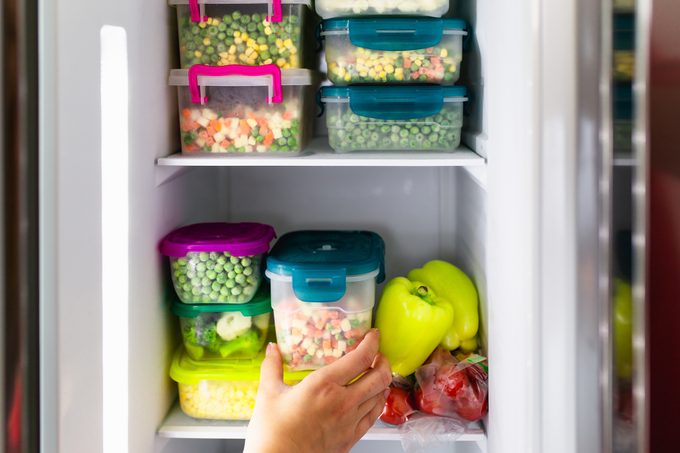How to Freeze Fresh Foods to Prevent Waste
Updated: Mar. 08, 2022
Use these simple tips to freeze fresh food, safely preserve its quality, and extend your supply to prevent waste.
During the coronavirus pandemic, grocery stores and farmer’s markets are among the few places you’re able to visit, especially if you live in a state with a stay-at-home mandate. We all need food and supplies. But if your goal is to venture out less often and reduce your chances of developing Covid-19, then it’s important to extend your grocery haul. One of the best ways to do this is to freeze fresh foods and meals for later use. Here are some simple tips and guidelines for effective freezing—and thawing. You may also want to check out the frozen foods nutritionists actually buy.
Blanch and freeze fresh veggies
Blanching most vegetables before freeing reduces enzyme activity, which helps preserve the flavor, color, texture—and slow the loss of nutrients. According to the University of Minnesota Extension, there are two blanching methods: boiling or steaming. The latter involves steaming the veggie for a specific number of minutes, and then cooling immediately in ice water before draining, drying, and storing. Submerging veggies into boiling water using a wire basket is also an option in place of steaming. Blanching times vary based on the vegetable and method. For example, broccoli requires steam blanching for five minutes but boiling for just three minutes, while whole carrots need to be steamed for eight minutes or boiled for five. Underblanching can stimulate the activity of enzymes rather than halting them, and over blanching can reduce nutrients and veggie quality, so adhering to targeted times is vital. Visit the university’s website for a handy guide to blanching instructions and optimal times.
Mash and then freeze avocados
The water in avocados expands when frozen, which can make the fruit mushy when thawed. For a better texture, mash it first. To prevent darkening, the Colorado State University Extension recommends adding a half tablespoon of lemon juice for each avocado before you freeze. Use your supply to make guacamole, sauces, dips, and green smoothies.
Use this trick to freeze fruit
If you have space in your freezer, place fresh fruit that’s been washed and patted dry on a baking sheet with spaces in between to prevent clumping, including whole berries and banana slices. Once frozen, transfer to freezer-safe storage containers. And if your fruit is very soft, like ripe mango, puree before freezing, according to the Ohio State University Extension.
Avoid freezing these foods if you can
Not all foods freeze well. According to the National Center for Home Food Preservation (NCHFP), some foods can become limp, tough, soggy, rubbery, or separated when frozen. These include cabbage, celery, cucumbers, lettuce, egg whites, and sour cream. Certain spices and seasonings can also change flavor after freezing, like onion and paprika, or become more intense and bitter, including cloves and garlic. For the full list of foods to freeze with caution, check out the chart on the NCHFP’s website.
 Choose the right storage containers
Choose the right storage containers
You may be tempted to recycle a resealable bag or empty yogurt container for freezer storage, but neither is appropriate according to the Michigan State University Extension. Single-use containers do not produce airtight seals and aren’t moisture-vapor resistant, so they can result in water loss and freezer burn. Look for freezer bags, not just storage bags, and other sealable containers labeled specifically for freezer use. Check out these food storage tips.
Date your food before you store
While freezing can preserve food quality, it won’t do so indefinitely. According to the Food and Drug Administration, frozen meals, like soup and cooked meat dishes, will keep for two to three months. Fresh fish varies by type, with raw lean fish remaining safe for six to eight months, fatty fish just two to three months, cooked fish four to six months, and smoked fish two months. Before placing anything in the freezer, be sure to label what it is, and mark the date, so you won’t lose track of when to use or toss. Here are the food expiration dates you should stick to.
Use or thaw frozen foods properly
Some frozen foods don’t need to be defrosted. For example, blend frozen greens, berries, and banana slices to smoothies. Others can be cooked from the frozen state without thawing, like veggies that go straight to a sauté pan, or frozen fruit you can warm on the stovetop to add to oatmeal. Frozen vegetables can also be added directly to recipes, like a stir fry, soup, or stew. According to the U.S. Department of Agriculture, it is safe to reheat frozen leftover dinners without thawing, including in a microwave. Use microwave-safe dishes, like glass or ceramic, cover, rotate the food for even heating, and add some liquid if needed. Just be sure the covering is also microwave safe, and vent the lid or wrap to let the steam escape. The moist heat will help destroy harmful bacteria and ensure uniform cooking. However, for optimal food safety, use a food thermometer to ensure that your food reaches 165 degrees F. And for foods you’d like to thaw before use, do so in the refrigerator, never at room temperature, which can allow bacteria to thrive that you can’t see, smell, or taste according to the Academy of Nutrition and Dietetics.
If you’re new to freezing your food, take it one step at a time. Be sure you have proper containers, check those dates, and use your frozen food safely. With the right measures, you can maintain the quality and nutritional value of your food, and prolong your supply. Next, read the frozen foods you should avoid at all costs.














